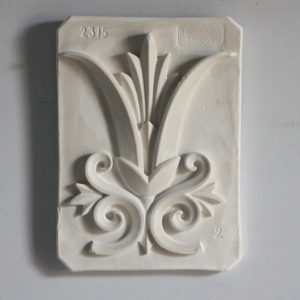No products in the basket.
An English plaster plaque, cast in relief with a stylised tulip,
Cast by LASSCO from a Victorian original by D.Brucciani & Co., bearing the original maker's stamp and a further stamp reading "Published May 1882",
the rectangular plaque with a wire loop to the back for wall mounting,
£65
In stock (can be backordered)
Domenico Brucciani (1815-1880) was born in Lucca (now in Italy), moved to London as a young man, and by at least 1837, with a Gallery of Casts in Covent Garden, became a revered formatore – plaster-caster. His business built up special links with both the British Museum and the South Kensington Museum (later named The Victoria and Albert Museum).
His most substantial commission for the South Kensington Museum was the casting of the Pórtico de la Gloria, the 12th-century façade of the cathedral at Santiago de Compostela, in 1866. This huge undertaking – and many others including, famously, Trajan’s column itself – followed the agreement forged by Henry Cole and Prince Albert at the Paris Exposition of the previous year, signed by all the Crowned Princes of Europe, to further the common man’s experience of sculpture in-the-round by the reciprocal casting of great European sculpture. What followed was the Cast Courts at prestigious museums across Europe and beyond; Brucciani was foremost among the formatore.
He taught sculpture, moulding and casting at the Royal College of Art (including National Art Training School) from 1853 to 1861.
His company, D Brucciani & Co, with workshops in Clerkenwell, survived its founder with the Covent Garden outlet still operating into Edwardian times. A catalogue of their wares is held at The National Art library. However, by the turn of the century, the direct casting of priceless sculpture was being frowned upon – travel across Europe was now much easier anyway – the common man could now use the train. The company faltered. In the 1920’s its casting workshops were subsumed by the Victoria & Albert Museum.






